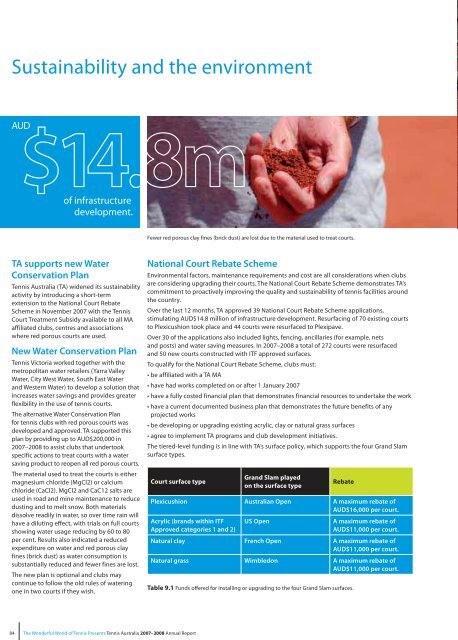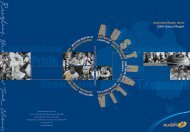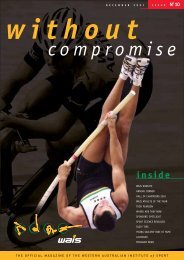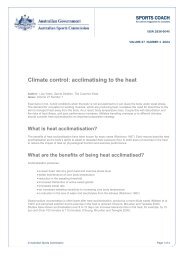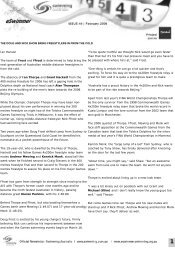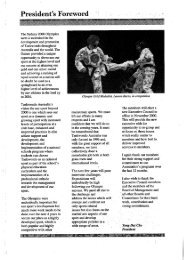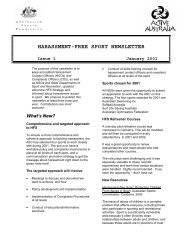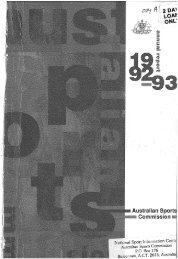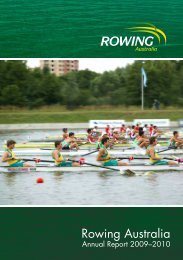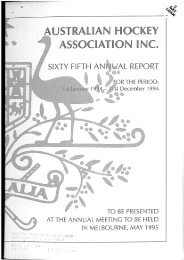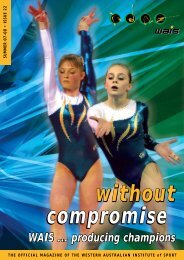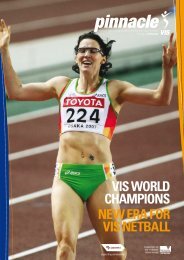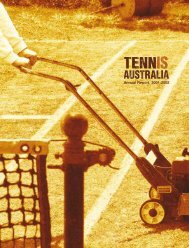0708 - Australian Sports Commission
0708 - Australian Sports Commission
0708 - Australian Sports Commission
You also want an ePaper? Increase the reach of your titles
YUMPU automatically turns print PDFs into web optimized ePapers that Google loves.
Sustainability and the environment<br />
AUD<br />
$14.8m<br />
of infrastructure<br />
development.<br />
TA supports new Water<br />
Conservation Plan<br />
Tennis Australia (TA) widened its sustainability<br />
activity by introducing a short-term<br />
extension to the National Court Rebate<br />
Scheme in November 2007 with the Tennis<br />
Court Treatment Subsidy available to all MA<br />
affiliated clubs, centres and associations<br />
where red porous courts are used.<br />
New Water Conservation Plan<br />
Tennis Victoria worked together with the<br />
metropolitan water retailers (Yarra Valley<br />
Water, City West Water, South East Water<br />
and Western Water) to develop a solution that<br />
increases water savings and provides greater<br />
fl exibility in the use of tennis courts.<br />
The alternative Water Conservation Plan<br />
for tennis clubs with red porous courts was<br />
developed and approved. TA supported this<br />
plan by providing up to AUD$200,000 in<br />
2007–2008 to assist clubs that undertook<br />
specific actions to treat courts with a water<br />
saving product to reopen all red porous courts.<br />
The material used to treat the courts is either<br />
magnesium chloride (MgCl2) or calcium<br />
chloride (CaCl2). MgCl2 and CaC12 salts are<br />
used in road and mine maintenance to reduce<br />
dusting and to melt snow. Both materials<br />
dissolve readily in water, so over time rain will<br />
have a diluting eff ect, with trials on full courts<br />
showing water usage reducing by 60 to 80<br />
per cent. Results also indicated a reduced<br />
expenditure on water and red porous clay<br />
fines (brick dust) as water consumption is<br />
substantially reduced and fewer fines are lost.<br />
The new plan is optional and clubs may<br />
continue to follow the old rules of watering<br />
one in two courts if they wish.<br />
84 The Wonderful World of Tennis Presents Tennis Australia 2007–2008 Annual Report<br />
Fewer red porous clay fines (brick dust) are lost due to the material used to treat courts.<br />
National Court Rebate Scheme<br />
Environmental factors, maintenance requirements and cost are all considerations when clubs<br />
are considering upgrading their courts. The National Court Rebate Scheme demonstrates TA’s<br />
commitment to proactively improving the quality and sustainability of tennis facilities around<br />
the country.<br />
Over the last 12 months, TA approved 39 National Court Rebate Scheme applications,<br />
stimulating AUD$14.8 million of infrastructure development. Resurfacing of 70 existing courts<br />
to Plexicushion took place and 44 courts were resurfaced to Plexipave.<br />
Over 30 of the applications also included lights, fencing, ancillaries (for example, nets<br />
and posts) and water saving measures. In 2007–2008 a total of 272 courts were resurfaced<br />
and 50 new courts constructed with ITF approved surfaces.<br />
To qualify for the National Court Rebate Scheme, clubs must:<br />
• be affiliated with a TA MA<br />
• have had works completed on or after 1 January 2007<br />
• have a fully costed financial plan that demonstrates financial resources to undertake the work<br />
• have a current documented business plan that demonstrates the future benefits of any<br />
projected works<br />
• be developing or upgrading existing acrylic, clay or natural grass surfaces<br />
• agree to implement TA programs and club development initiatives.<br />
The tiered-level funding is in line with TA’s surface policy, which supports the four Grand Slam<br />
surface types.<br />
Court surface type<br />
Grand Slam played<br />
on the surface type<br />
Rebate<br />
Plexicushion <strong>Australian</strong> Open A maximum rebate of<br />
AUD$16,000 per court.<br />
Acrylic (brands within ITF<br />
Approved categories 1 and 2)<br />
US Open A maximum rebate of<br />
AUD$11,000 per court.<br />
Natural clay French Open A maximum rebate of<br />
AUD$11,000 per court.<br />
Natural grass Wimbledon A maximum rebate of<br />
AUD$11,000 per court.<br />
Table 9.1 Funds off ered for installing or upgrading to the four Grand Slam surfaces.


